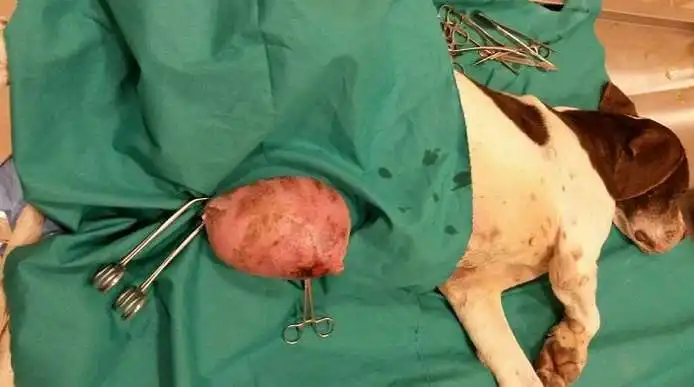4- MAMMARY TUMORS IN CATS AND DOGS
Mammary Tumors In Cats and Dogs
Mammary tumors in cats and
Throughout the postpartum and lactating periods, these glands experience substantial hormonal pressure. When the puppies or kittens transition to solid food, the milk in the mammary glands is no longer necessary. However, if milk remains unexpressed in the breast, it can lead to various risks. The residual milk can be susceptible to degradation by pathogenic microorganisms, causing local infections. This condition, known as mastitis, often results in swollen local lymph nodes. It’s important to note that this situation, which can manifest as a cold abscess or cyst, is frequently associated with the development of mammary tumors.
However, it’s crucial to recognize that not all swellings in the mammary glands are indicative of tumors. The causes, formations, and tissues of mammary tumors vary.
Although the precise causes of mammary tumors remain elusive, it is believed that female sex hormones play a significant role. Breast tissue is approximately five times more susceptible to tumor formation compared to other reproductive organs. Mammary tumors rank as one of the most common types of tumors in dogs, second only to skin tumors. Female dogs between the ages of 5 and 10 are particularly prone to this condition. In both cats and dogs, mammary tumors can develop in a single breast lobe or simultaneously affect all lobes.
Mammary tumors can either develop directly in the mammary gland or spread from a primary tumor focus, a process known as metastasis. They occur in two distinct forms: malignant or benign. The incidence of mammary tumors is notably high in both cats and dogs.
Benign tumors (hyperplasia) tend not to metastasize. They lack ulceration, can be palpated under the skin, and exhibit slow growth. Their contours are regular and clearly defined.
In contrast, malignant tumors can spread to other organs in the body, contingent upon their growth rate and characteristics. Mammary tumors are more frequently observed in the inguinal breast lobes. The likelihood of malignancy is higher in comparison to other breast lobes. This is attributed to the extended and slower milk secretion in these mammary glands. Malignant tumors can also metastasize to other lymph nodes via lymph fluid and the bloodstream. They are characterized by ulceration, unclear contours, an inflammatory structure, potential color changes, lack of mobility under the skin, and adherence to the skin.
Causes of Mammary Tumors in Cats and Dogs:
Gender: Female pets are significantly more susceptible to mammary tumors than males.
Genetic Factors: The predisposition to cancer among individuals with a family history of the disease is a well-established fact. Similarly, pets inherit a genetic predisposition to cancer.
Breeds: Research indicates that small-breed dogs are more susceptible to the disease than larger breeds. Additionally, Siamese cats exhibit a higher susceptibility compared to other cat breeds.
Drugs: Prolonged use of hormone medications and synthetic hormones for pregnancy control are believed to contribute to the development of mammary tumors.
Endocrine System Disorders: Hormonal imbalances, ovarian cysts, and pseudo-pregnancies lead to mammary tumors by placing prolonged stress on hormone metabolism.
Milk Deposition in Breast: The presence of remaining milk in the breast, stemming from inadequate feeding of the offspring after birth (due to reasons such as the death of the offspring or early separation from the mother), can lead to swelling in local lymph nodes and the formation of unwanted cysts in breast tissue. Over time, these tissues may progress into tumoral formations.
Stress: While not conclusively proven, some opinions suggest that the stress experienced by a mother during and after birth can lead to hormonal imbalances, potentially triggering mammary tumors.
Nutrition Disorders: Both malnutrition and overfeeding are implicated in the development of mammary tumors. These tumors are commonly observed in overweight and obese pets, as well as in underweight ones.
Symptoms of Mammary Tumors
While mastitis, abscesses, lipomas, and cystic formations can sometimes be mistaken for mammary tumors, it’s also possible for enlargements related to infections in lymph nodes to be confused with these tumors. In cases of mastitis and abscesses, observable symptoms include redness and swelling of the breast tissue, along with a general deterioration in the animal’s condition.
Additionally, there may be an inflammatory and bloody discharge from the nipple. Local lymph nodes tend to swell, and in severe cases, the patient may develop symptoms resembling septicemia. This condition can be alleviated with the use of potent antibiotics and anti-inflammatory agents. However, it’s important to bear in mind that alongside the potential formation of cystic connective tissue or cold abscesses in the breast tissue, swollen lymph nodes may progressively develop into tumors over time, presenting a significant concern.
In cases of malignant mammary tumors, clinical symptoms may include a loss of appetite, fatigue, pain, and noticeable swelling. A painful lump integrated within the breast tissue can be identified. At times, these tumors may also become suppurative, resulting in a bloody and inflammatory discharge from the nipple. During clinical examination, swollen local lymph nodes can be observed, often resembling marbles in form and size, with variations in diameter. Malignant tumors are characterized by rapid growth.
During examination, benign tumors typically exhibit a more uniform and round shape, while malignant tumors tend to be amorphous and substantial.
Mammary tumors can have a detrimental impact on the quality of life for the affected animal, potentially affecting their overall well-being and daily activities
Treatment
Various treatment modalities are employed in managing mammary tumors, including chemotherapy, radiotherapy, immunotherapy, and surgical intervention. In the early stages, surgical removal is often the preferred method. It is crucial to conduct the operation while preserving as much healthy tissue as possible. Additionally, it may be necessary to remove local lymph nodes in conjunction with the tumor. Any tissue obtained through surgery or biopsy should be promptly sent for pathological examination. This step is vital for ongoing patient monitoring and treatment planning. Depending on the pathological findings, chemotherapy and immunotherapy may be recommended as post-operative measures.
In cases of mastitis and open-ended abscesses, medication can be effective. However, it’s important to note that cystic tissue that develops as a result and lymph nodes that are not recoverable must eventually be addressed through surgical intervention.
Points to Take Into Account Before the Operation
The appropriate time for the operation should be jointly determined by the patient’s owner and the veterinary physician. Subsequently, a comprehensive health assessment of the patient should be conducted in preparation for the operation. These examinations serve to evaluate the overall condition of the patient and ensure there is no risk associated with anesthesia. Therefore, ultrasound and blood tests should be administered. Since tumors in the mammary gland can potentially spread to the lymph nodes, brain, chest, bones, and spleen, preoperative chest radiography should be performed to ascertain whether the tumor has metastasized to the lungs.
If the patient has any drug allergies, this information must be communicated to the veterinary physician without fail.
The patient should refrain from eating for a period of 12-24 hours prior to the operation. This practice enables the patient to undergo anesthesia comfortably during the procedure.
Technique of the Operation
The patient, who has been administered a sedative for the operation, undergoes sterilization procedures in the preparation room. Initially, the area where the operation will take place is prepared by shaving the surrounding hairs and disinfecting it with an antiseptic solution. The patient is then escorted to the operating room where the preferred anesthesia method, determined by the veterinary physician, is administered. The area is carefully demarcated with a sterile cloth, making it ready for the surgical intervention.
The operative site primarily encompasses the mammary gland containing the tumor, along with its adjacent tissue. Access to the tumoral mass is gained through an incision in the skin. It is imperative to ensure complete removal of the tumoral tissue, as tumors tend to be highly vascular and prone to bleeding during the operation.
Therefore, the surgical area must be sufficiently wide, and the procedure should be conducted through healthy tissues. Even small remnants of the tumoral mass can lead to metastases and recurrence. Given that veins connecting the mammary glands facilitate the spread of tumor cells, it is essential to perform the operation not only on the affected breast lobe but also on all mammary glands on the same side. In cases where tumors develop on both sides, the entirety of the mammary glands should be removed.
Hormones play a significant role in both the formation and recurrence of mammary tumors. Therefore, consideration may be given to performing an ovariohysterectomy during the mammary tumor operation.
Subsequently, the muscles and skin are meticulously sutured, and the operation is concluded.
Points to Take İnto Account After the Operation
The antibiotics administered after the operation should be of the duration and dose recommended by the veterinary physician. WinPet Medvest should be absolutely used as the patient will harm the operation area by licking and biting (See Video). Sudden movements that may create a risk such as jumping should be avoided.
Pain killers can be used when needed.
Complete recovery is completed within about 10-12 days and sutures can be removed.
If there is a condition such as swelling, redness, inflammation etc. occurs due to a possible edema in the region in this period, the veterinary physician should be consulted as soon as possible.
Possible Complications After the Operation
Complications are rare when proper sterilization procedures and suitable materials are utilized during the operation, along with regular post-operative antibiotic administration.
Nevertheless, it is crucial to steer clear of excessive and inappropriate physical activities during the recovery period, and to safeguard the sutures. WinPet MedVest should remain in place throughout the recovery phase to prevent eventration (the opening of sutures and protrusion of viscera).
The most significant potential complication post-operation is the risk of tumor recurrence in the future. As a result, it is imperative to monitor the patient periodically.
Protection
The most crucial safeguard for female pets is early spaying. Spaying procedures conducted before puberty significantly reduce the risk of mammary tumors. The protective effect against mammary tumors is minimal for pets spayed after the age of 2 or those that have given birth at least once.
Timely detection and treatment are paramount for both dogs and cats. Owners of female cats and dogs should conduct regular manual examinations of the mammary glands every three months. If any changes are observed, it is imperative to consult a veterinary physician promptly. Mammary tumors can manifest as small, round masses or as larger, irregularly shaped growths. Additionally, palpation examinations may reveal swollen local lymph nodes associated with the tumor.
Recent studies have demonstrated that prolonged use of hormone medications can act as a trigger for mammary tumors. Consequently, it is advised to steer clear of extended usage of hormone drugs. When it comes to reproductive control, surgical spaying methods are the preferred approach.
If you want to read our other articles, click on them.

